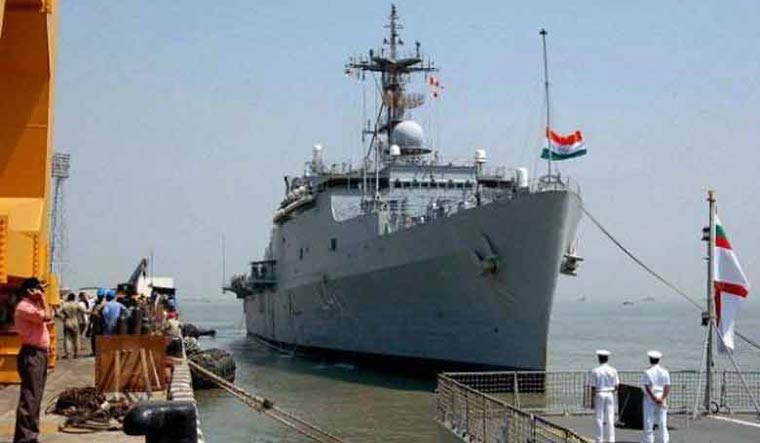Everyone wants to be strong and self-sufficient, but few are willing to put in the work necessary to achieve worthy goals. – Mahatma Gandhi
While India gained its independence on August 15, 1947, the seeds of an Indianised Navy were sown way before in January 1947 by a British citizen, Patrick Blackett. A renowned British physicist who had pioneered naval operational research in the British Navy during the Second World War, Blackett prepared a report outlining measures necessary for India to become near self-sufficient in defence production. While Blackett correctly assessed self-reliance as key to maintaining strategic autonomy in terms of foreign policy, ably supported by a strong industrial base, his analysis of requiring 18 months to achieve it did not prove true.
The journey towards self-reliance has been long and arduous, impacted by financial limitations, international sanctions and global politics. Yet, the Indian Navy has remained steadfast in this mission. Taking a cue from what Dr A.P.J. Kalam had once said, the dream to achieve self-reliance in all aspects of maritime operations was one which did not let the Navy’s leadership to ever sleep. The commitment was espoused even at the individual level as much as it was ingrained into the very ethos of the organisation. Notwithstanding the considerable challenges, such an attitude ensured continuous investment of two key elements―first being the financial capital and second the human capital, which enabled steady improvement and positive outcomes. The unique involvement of the Navy, both, as the vendor as well as the buyer, enabled a progressive model of indigenisation to be successfully implemented.
Anyone who has spent time at sea will vouch that, in addition to ‘the proverbial enemy’, there is another threat which permeates across peace and war, and that is the sea itself. A deadly mix of salt, water, multi-dimensional motion, oil, ammunition and electricity, all packed into a box of steel, makes routine tasks difficult and the difficult, nearly impossible. While hulls can be strengthened with better steel and engines made more powerful, making electronic systems operate reliably in such hostile environment is exponentially more complicated. It is, therefore, no surprise that unlike the float and move components, which saw early success, the journey to achieve self-reliance in terms of fight component has been relatively arduous. The Navy persevered, and like the confrontation between the stream and the rock, which the stream always wins―determination, professionalism and self-confidence has now resulted in success.
The first major step on this path was when the Navy took a decision to move away from analog systems, already fitted on the first Leander class ship, to digital systems manufactured by the Dutch company, Signaal for subsequent ships. Despite objections from the ship-builder from some quarters within the Navy, the higher leadership was able to discern the long terms advantages, and pushed ahead. This culminated in an agreement between Signaal of Holland and Bharat Electronics (BEL), Bengaluru, which has enabled the latter to subsequently manufacture radar systems like APARNA, LW-08 and DA-08. These systems remained the mainstay of Naval radar systems for years, and BEL (Bangalore) has now achieved adequate capability to supply one of the world’s most advanced radar systems―MF-STAR, for the next generation of naval frigates.
The Indian Navy has also achieved self-reliance in terms of technology as well as manufacturing in the niche field of sonar systems. This was made possible by a synergetic relationship between the Navy, Naval Physical and Oceanographic Laboratory (NPOL), a premier DRDO laboratory dealing with underwater acoustics and M/s BEL (production agency). The difficulties in making western-origin sonars work in tropical waters and rapid advancement in technologies convinced the Navy to indigenise underwater sensors. The journey, which started in 1976, was excruciating, but bold decisions at the highest level helped the Navy navigate this project through difficult waters. Facilitating the participation of highly specialised individuals, alongside teams from DRDO and the academia, all driven by a shared single-minded focus resulted in the development of APSOH, an indigenously designed, developed and manufactured world class sonar. Since then, every Indian Naval ship has been fitted with indigenous sonars, comparable with sonars operated by leading navies of the world, which have been built on the efforts of this initial team.
Amongst all the components on a warship, Electronic Warfare (EW) systems and Computer Aided Action Information Organisation Systems (CAAIO) function at the very cutting edge of technology. Thus, while leading firms are ever ready to sell these systems, they remain unwilling to share the technologies within. Considering the complex technologies involved, a staged development model was adopted by the Navy for both these systems. While the first set of systems, such as Ajanta and EMCCA, were satisfactory, subsequent generations of these systems have surpassed expectations. Today, all newly inducted assets employ indigenously built Combat Management Systems (CMS) and large ship EW Systems which are comparable, if not better, than what is available worldwide.
Amongst this, the indigenous CMS program is of particular pride to the Navy due to the significant participation of the private sector, the crowning glory being successful development of CMS for the indigenous aircraft carrier by M/s Tata Power (SED). A focussed approach towards enhancing private sector participation has yielded rich dividends with M/s Larsen &Toubro supplying the Indigenous Torpedo Tube Launchers, Indigenous Rocket Launcher and Universal Vertical Launch Systems. The development of niche technologies is today no longer the forte of the so-called big boys. MSMEs, based on experience gained by working alongside the Navy, have also made a mark by winning international contracts, beating global giants in the process.
The Navy has also been at the forefront in initiating ground breaking projects through the inter-governmental joint-development model. The BrahMos Aerospace venture between India and Russia, set up in 1998, was able to deliver a supersonic anti-ship missile within just five years. Repeated success has proven this missile’s game-changing credentials and BrahMos is today the standard fit onboard IN ships. The induction of Barak-8 systems into the Navy, commencing with the indigenously built Kolkata class ships in 2014, has been a game changer in terms of air-defence capabilities.
When the Honourable Raksha Mantri, Shri Rajnath Singh, announced an embargo on import of over 100 weapons and platforms, there was worry in certain quarters regarding its impact on the Armed Forces’ capability enhancement plans. Yet, a quick perusal of the list actually reveals the triumph of the Indian Navy’s indigenisation program. The sustained efforts to attain self-reliance over the past six decades has ensured that, the Navy’s plans, as enunciated in its Maritime Capability Perspective Plan, remain on track. Though there remains a need to enhance participation of the private sector, there is no denying the lead that the Navy has towards Be Indian, Buy Indian. One of the foremost examples of the Indian Navy’s indigenisation is undoubtedly the Indigenous Aircraft Carrier-1 (IAC-1) being built at Cochin Shipyard Ltd. The IAC-1 has provided direct employment to the shipyard, MSMEs and has ploughed back most of its budget back into the country’s economy. The Navy is also keen to similarly construct IAC-2, which will not only give a boost to the economy, but also ensure that two Carrier Battle Groups are continuously available.
The geo-political churn in the Indian Ocean Region and growing presence of external maritime forces has significantly enhanced the challenges faced by India in the maritime domain, which could also consequently impact economic growth. The desire to be Atmanirbhar, ingrained into its very DNA, has enabled the Indian Navy to become increasingly self-reliant yet strong―strong enough to be rated as the fifth most powerful Navy in the World by the Lowy Institute Asia Power Index 2020. However, less than adequate capital investment in the Navy may see a steady erosion of this carefully nurtured indigenous manufacturing capability. With Ministry of Defence taking a lead in the Atmanirbhar initiative, it is imperative that the Government continues to support the Navy and in turn, the indigenous industry, to ensure greater success in our national mission to achieve comprehensive self-reliance.
Captain Deepak Nair is a serving Indian Naval Officer presently posted at Defence Services Staff College, Wellington, and has keen interest in niche military technologies
The contents of this article are the personal views of the author and do not represent official position of the Indian Navy or the Government of India










